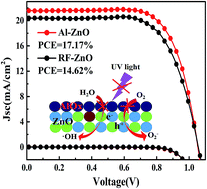Enhanced efficiency and environmental stability of planar perovskite solar cells by suppressing photocatalytic decomposition†
Abstract
The environmental instability of perovskite solar cells caused by the ultraviolet photocatalytic effect of metal oxide layers is a critical issue that must be solved. In this paper, we report improved environmental stability of ZnO film-based planar heterojunction perovskite solar cells, by suppressing photocatalytic activities induced by the ZnO electron transfer layer. The photovoltaic performance and stability in an ambient environment under continuous illumination are effectively improved by applying an aluminum oxide interlayer on the ZnO film to suppress the photocatalytic degradation of perovskites. The highest efficiency of solar cells has increased from 14.62% to 17.17%, and after 250 h of continuous exposure under full spectrum simulated sunlight in air, the efficiency remains as high as 15.03%. The results suggest that effective suppression of photocatalytic degradation of perovskites with a modified electron transfer layer is a new solution to improve the long-term environmental stability of perovskite solar cells.



 Please wait while we load your content...
Please wait while we load your content...